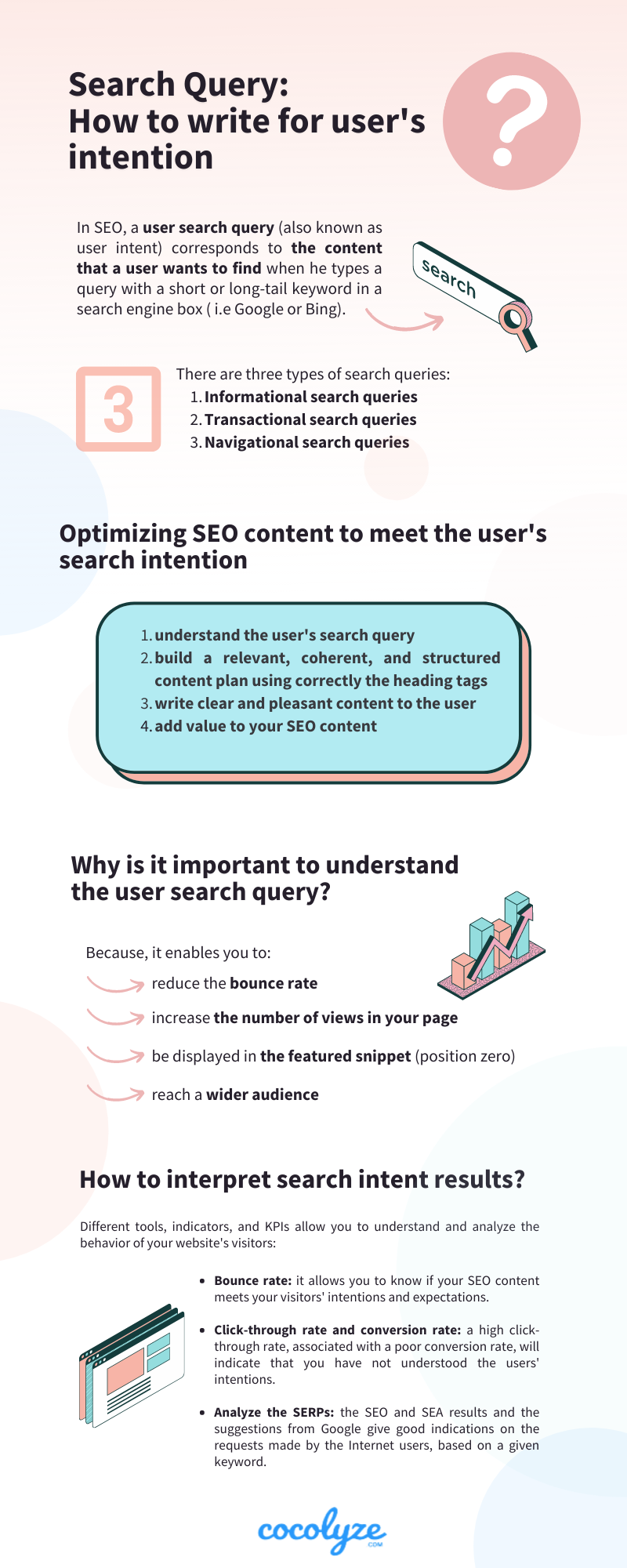Search Query: How to write for user's search intention
It's not a secret for any web editor or any SEO professional in general, search engines - and especially Google - want to offer more qualitative and accessible content to their users.
To achieve this goal, Google keeps improving its algorithms year after year, to better understand what is going on in the minds of Internet users when they search on the web.
By compiling data and updates, the Mountain View company is becoming progressively more precise in the return of results.
Of course, SEO web writing must adapt to these changes and offer content that can meet the needs of search engine bots to be properly indexed and ranked.
That's why we can affirm today, in the light of its evolutions, that the main objective of an SEO strategy is to be visible on search engines, as well as to answer users' needs.
Thus, responding to the search intent of its targets must be a priority for any SEO web writer or content manager.
But how do you go about producing and delivering quality SEO content, capable of meeting the search queries of your users? How do you identify these search intents? And what is the impact of the emergence of voice searches on SEO web copywriting?
Main Topics:
1. What is a search query?
- Informational search queries
- Transactional search queries
- Navigational search queries
2. How to optimize SEO content to meet the user's search intention
- How to understand the user search intent
- Building a coherent and relevant plan for your SEO content
- Writing clear and fluid SEO content
- Adding value to your SEO content
3. Why is it important to target user search intent?
4. How to understand/interpret search intent results?
5. How do you deliver SEO content for voice search?
What is a user search query?
A user search query (also known as user intent) in SEO corresponds to the content that a user wants to find when he types a query with a short or long-tail keyword in a search engine (Google, Bing, etc...). There are 3 types of user search intentions: informational, transactional, and navigation.
Informational Search Query - To learn something
This is a search generally made from a keyword. During this search, the Internet user does not have a precise idea about the website where he will find the information. This often leads to the consultation of several sites to find what he/she is looking for.
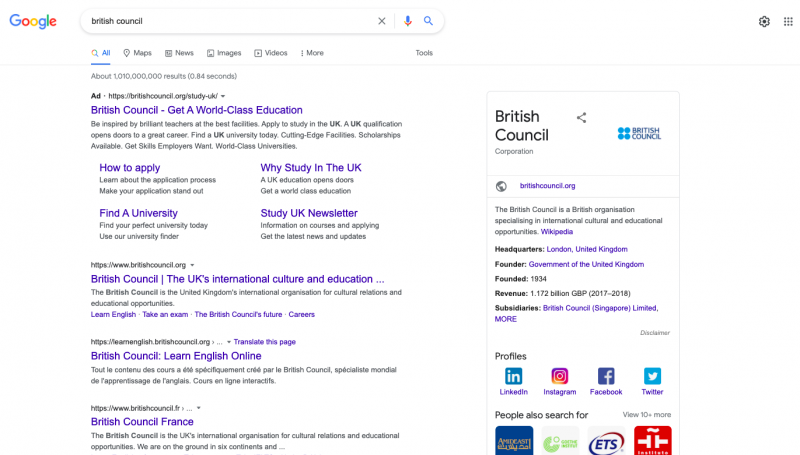
For example, in the picture above, I'm looking for information about the British Council. We can notice that a great diversity of websites can provide many elements on this subject. Internet users can visit several sites to get information. They can also make a more precise request to find the desired information.
Transactional Search Queries - To do something
A transactional search is a search performed to purchase a product or service. By extension, we consider that this type of search is intended to lead to a conversion action (purchase, registration, subscription, ...).
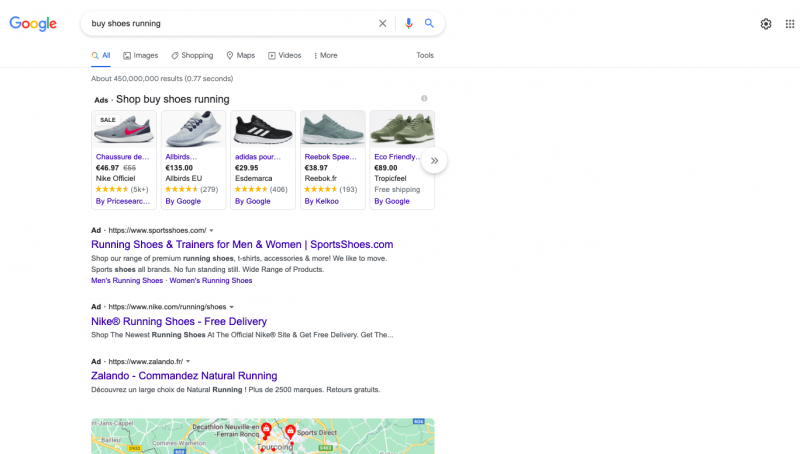
Navigational Search Queries - Getting Somewhere
Navigational search queries are searches performed to get to a physical location or website. This type of search implies that the user wants to go to a specific location or website.
For example, a user will type "Vodafone Birmingham" to find either the website of a Vodafone or to find the address of a store in Birmingham, he wants to go to.

How to optimize SEO content to meet the user's search intention
First of all, you must respect the following steps to provide quality content, optimized and be ready to meet the needs of Internet users:
- understand the user's search query
- build a relevant, coherent, and structured content plan using correctly the heading tags
- write clear and pleasant content the user
- add value to your SEO content
If you don't feel comfortable in the exercise of SEO copywriting, you can call for web content writers via the TextBroker platform for example.
Cocolyze's SEO Writing Assistant Tool also allows you to create optimized SEO content and gives you the necessary recommendations on the ideal length of the content, the occurrence of your keywords, the structure of the content, etc.

How to understand the user search query
This step requires putting yourself in the shoes of Internet users and asking the following questions:
It is also possible to rely on Google suggestions and the first results in the SERPs.
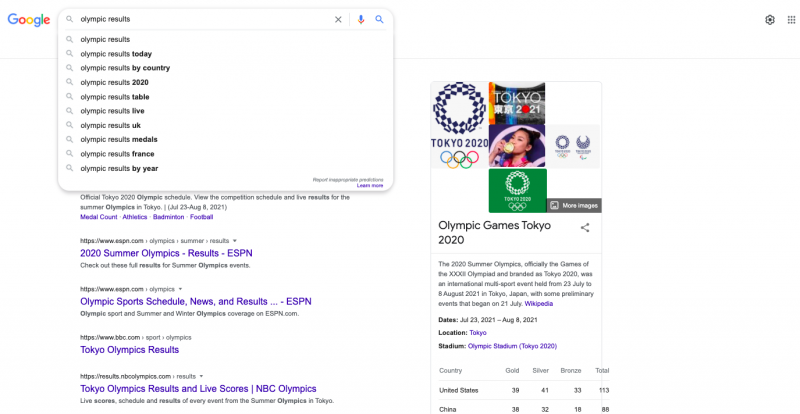
Google Ads tools, or Answer the public are other ways to find search intent that are related to a keyword.
🚨 Don't forget to log out of your Google accounts! If you stay logged in with your profile, Google will be influenced by your previous searches, which will bias the results of the search engine suggestions.
Depending on the type of search, a user will have different ways to proceed:
In the case of an informational search query (which constitutes 80% of the searches on the search engines), the user will either look for several sources of information to answer his questions or will simply limit himself to the "featured snippet" (see the example below), which will bring him the information he is looking for directly on the screen.

Queries, in the context of an informational search, most often start with: why, what, who, where, when, how.
With these types of queries, you can increase your SEO traffic by :
- educating your visitors about a topic, products, etc
- getting backlinks: informative content is often shared
- increasing your reputation: content produced in the context of an informational search allows you to highlight your expertise on a subject, in a field, ...
For navigational search queries Internet user wants to find a specific piece of information.
For example the price of a Cocolyze subscription.
Knowing that these queries contain the brand or the place desired by the user, SEO has less influence. However, it is important to integrate, at least, the name of your brand and/or location in your title tag and H1 title tag to be correctly indexed.
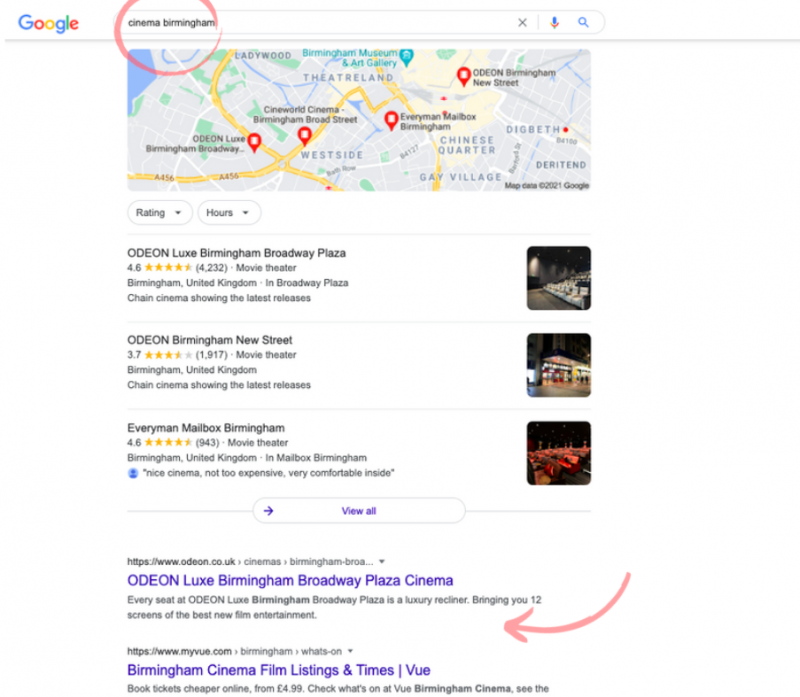
When it comes to a transactional search query, it is, therefore, important to specify that they are to be distinguished from a "commercial" intention, in which the Internet user is turned solely to the purchase of a product or service without getting information.
Build a coherent and relevant plan for your SEO content?
Do not lose sight of the fact that the most important thing is to give all the information that the user is looking for, as quickly as possible. This information should therefore be placed at the beginning of the page as a priority.
It is also important to include the information in the heading titles (H2, H3, H4) of your pages, in order to allow the user to easily find the information.
Write clear and fluid SEO content
You wouldn't read a book with bad spelling, punctuation errors, etc. The same goes for the pages of a website.
For the editorial process of your SEO contents :
- Prefer the use of short sentences.
- Diversify the lexical field around the keyword. This brings variety and semantic richness appreciated by users and search engines.
- Your content must be well spaced out: make paragraphs of 4 to 5 lines maximum. This avoids endless blocks of text. Also, use bulleted lists to list your ideas.
- Don't hesitate to use Cocolyze's SEO Writing Assistant tool to optimize your content.
Add value to your SEO content
Adding value and elements that distinguish you from other content will allow you to attract more attention from your target audience and from Google.
For a user who is searching for information (informational search), you must :
- offer quality information
- integrate images and/or videos, infographics, useful references to complete your content, etc.
In case of a transactional search, do not hesitate to use :
- customer testimonials, concrete cases, .... in order to be credible in the eyes of Internet users
- use call-to-actions (or action buttons) to facilitate access to the purchase
- offer subscriptions to newsletters
- place FAQs
- integrate a chatbot
Why is it important to target user search intent?
Defining and precisely targeting users' search intentions will lead to :
- a decrease in the bounce rate: content that answers to what users expect and to their needs will be read more and users will spend more time on your page.
- Google will appreciate that users stay on your page because it means that your SEO content is relevant and of quality.
- As a reminder, we consider that there is a "bounce" when the user :
(1) closes the page of your site almost immediately
(2) goes back by clicking on previous
(3) remains inactive for more than 30 minutes
(4) leaves your site by using an external link, or by typing the address of another site in the URL bar
- an increase in the number of views: identifying the most interesting queries and ranking on the right keywords, will generate an increase in traffic to your site. As a result, you will have a better ranking and an increase in your visibility on search engines.
This can create a snowball effect, as users may also be interested in other content on your site, which may see their ranking improved.
- the possibility to appear in the featured snippet: on Google, a featured snippet (or zero position) is a way to display a result in the SERP. It is materialized in the form of a frame located above the organic results, which considerably increases visibility but causes a decrease in the click rate and the number of visits.
- the possibility to reach a wider target: targeting search intents and optimizing content according to them allows you to widen your SEO scope. This is not as valid when targeting only one search term. Google can now interpret different search expressions as belonging to the same search intent.
How to understand/interpret search intent results?
Various tools, indicators, and KPIs allow you to understand and analyze the behavior of your site's visitors. This allows you to draw some useful conclusions and to know if you have identified the right user search queries:
- Bounce rate: This allows you to know if your SEO content meets your visitors' intentions and expectations. A high bounce rate will indicate that your content does not meet the needs of Internet users and/or that the user experience (UX) on your website is of poor quality (loading time too high, lack of user-friendly interface, 404 error page, ...).
- In some cases, your number of visits may be high, but your bounce rate may also be high. This means that you have perfectly identified the search intentions of the users and that you have achieved a good position with your content, but the content does not respond to the problems/needs of your target audience.
- Click-through rate and conversion rate:
A high click-through rate, combined with a poor conversion rate, will indicate that you have not understood the intentions of the users you are targeting. You will have used the right keywords, but you have not understood what users expect when they arrive on your pages.
Analyze the SERPs of the search engines: analyzing the SEO and SEA results and the Google suggestions will give you good indications on the queries made by the users, from the keyword you have targeted.
You can also use the Cocolyze Keyword tool to find :
- find the most searched keywords according to your sector of activity
- find keyword ideas around a theme
- find long-tail ideas
- find the keywords of your competitors and those that will be the easiest to work with
How do you deliver SEO content for voice search?
There are not really specific rules to follow to adapt content to voice search.
But we can see that the use of this type of search is growing. Whether it's via mobile or connected devices, Internet users seem to be getting less and less attracted to typing queries in search engines.
Could this be the end of the click rate?
Do not worry, we are not there yet. But the practices of Internet users lead us to believe that we will soon have to rethink the concept of organic referencing, which is still based mainly on what Internet users write when they do a search.
Are we heading towards a race for the zero position?
When a voice search is carried out, the most common words are: "Find", "Put", "Search" and "Search": "Find", "Put", "Play", "Broadcast", "Turn on", "Call". etc. And when we want to "Learn something", Google displays information contained in the results in position zero. As much to say that if the race to the featured snippet already exists, it will become ultra-competitive soon.
Conclusion
Users' search queries on the web can be grouped into 3 categories. It is essential to audit what users expect when they search for a keyword, in order to propose quality, coherent and structured content.
This approach will allow you to improve your bounce rate and increase your page views and conversion rates.
